Consumer Demographics Analysis: Household Expenditure in Town Z
VerifiedAdded on 2020/12/09
|10
|2022
|148
Report
AI Summary
This report provides a comprehensive analysis of consumer demographics, focusing on household expenditure patterns in Town Z. It begins with an examination of weekly household expenditure data, including calculations and chart interpretations illustrating spending trends across different age groups. The report then delves into the calculation and interpretation of the GINI coefficient for both Town A and Town B, assessing income distribution. Furthermore, it estimates equivalent average annual household expenditure, considering factors such as household size and age. The final section investigates the impact of population growth on income per capita, economic sustainability, and food consumption, drawing on various economic models and studies to support its arguments. The report concludes by discussing the implications of these findings on economic development and resource management.
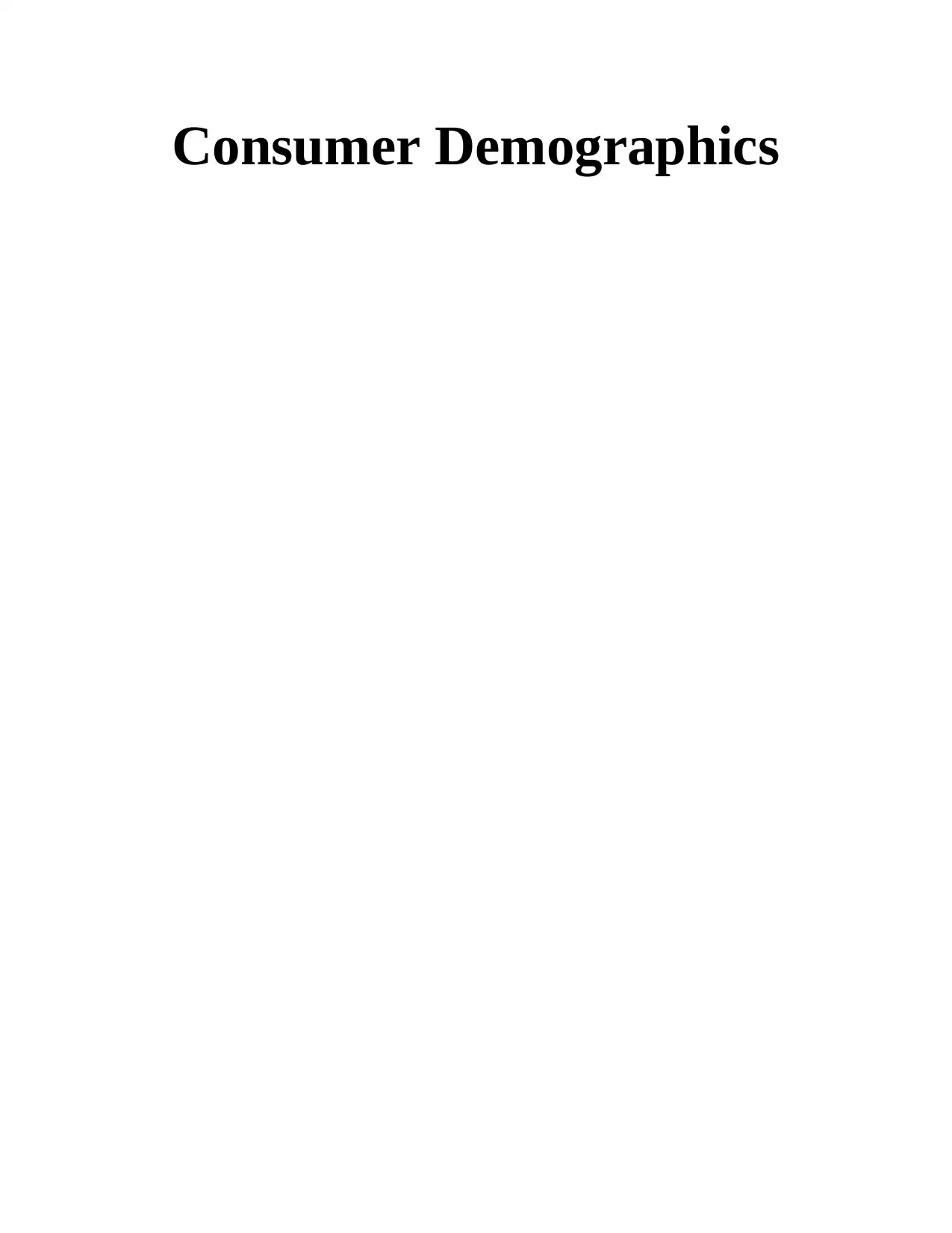
Consumer Demographics
Paraphrase This Document
Need a fresh take? Get an instant paraphrase of this document with our AI Paraphraser
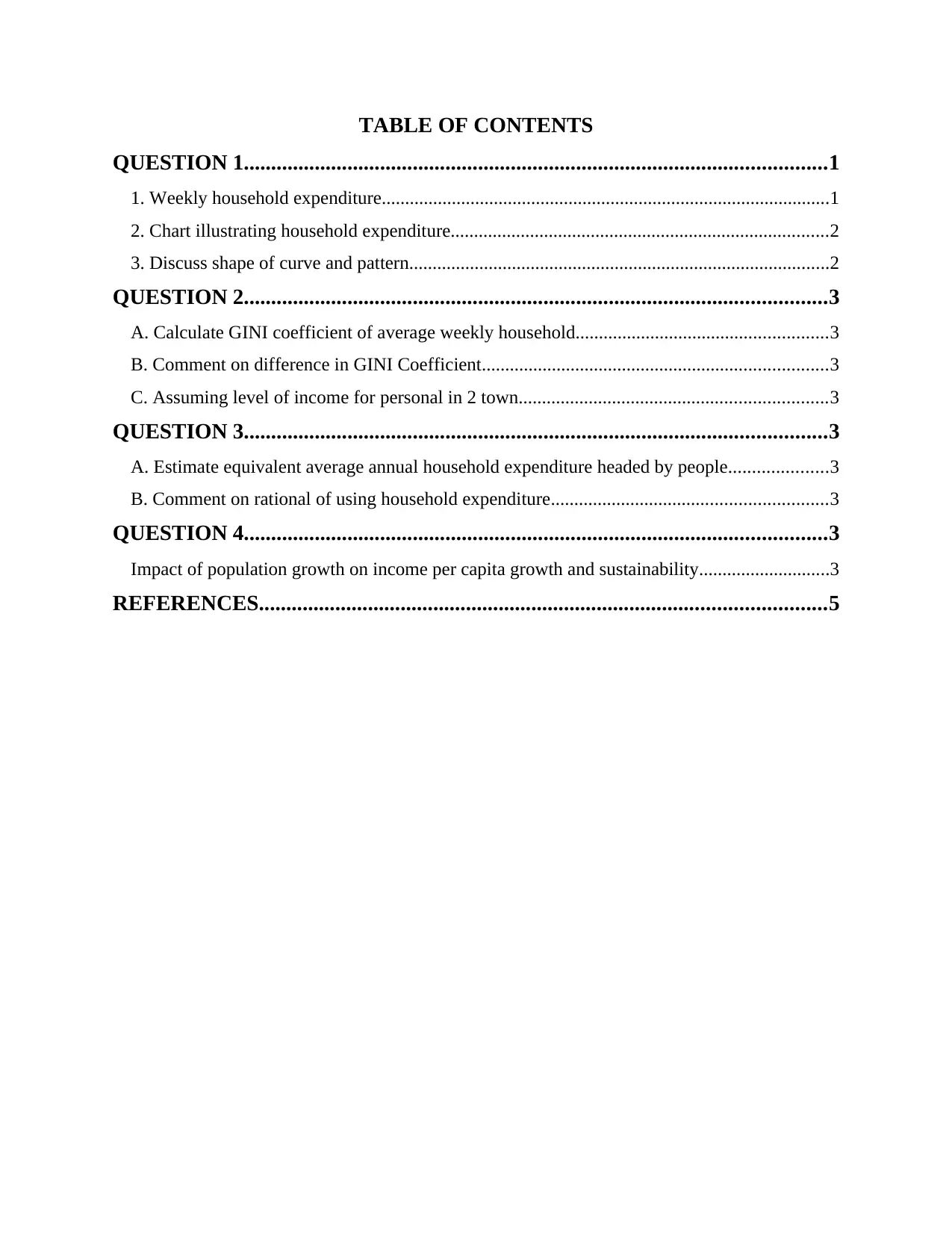
TABLE OF CONTENTS
QUESTION 1...........................................................................................................1
1. Weekly household expenditure................................................................................................1
2. Chart illustrating household expenditure.................................................................................2
3. Discuss shape of curve and pattern..........................................................................................2
QUESTION 2...........................................................................................................3
A. Calculate GINI coefficient of average weekly household......................................................3
B. Comment on difference in GINI Coefficient..........................................................................3
C. Assuming level of income for personal in 2 town..................................................................3
QUESTION 3...........................................................................................................3
A. Estimate equivalent average annual household expenditure headed by people.....................3
B. Comment on rational of using household expenditure...........................................................3
QUESTION 4...........................................................................................................3
Impact of population growth on income per capita growth and sustainability............................3
REFERENCES........................................................................................................5
QUESTION 1...........................................................................................................1
1. Weekly household expenditure................................................................................................1
2. Chart illustrating household expenditure.................................................................................2
3. Discuss shape of curve and pattern..........................................................................................2
QUESTION 2...........................................................................................................3
A. Calculate GINI coefficient of average weekly household......................................................3
B. Comment on difference in GINI Coefficient..........................................................................3
C. Assuming level of income for personal in 2 town..................................................................3
QUESTION 3...........................................................................................................3
A. Estimate equivalent average annual household expenditure headed by people.....................3
B. Comment on rational of using household expenditure...........................................................3
QUESTION 4...........................................................................................................3
Impact of population growth on income per capita growth and sustainability............................3
REFERENCES........................................................................................................5
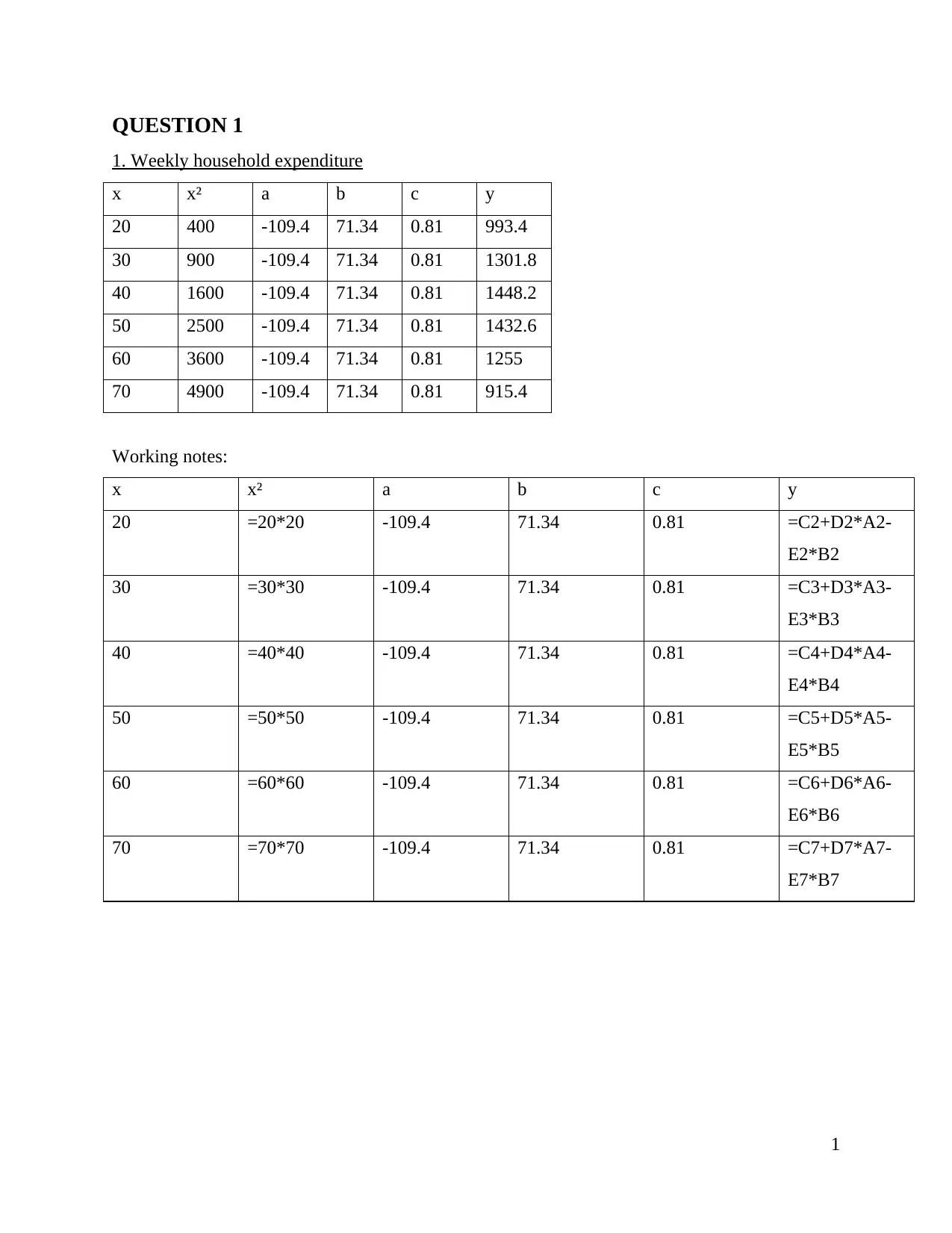
QUESTION 1
1. Weekly household expenditure
x x² a b c y
20 400 -109.4 71.34 0.81 993.4
30 900 -109.4 71.34 0.81 1301.8
40 1600 -109.4 71.34 0.81 1448.2
50 2500 -109.4 71.34 0.81 1432.6
60 3600 -109.4 71.34 0.81 1255
70 4900 -109.4 71.34 0.81 915.4
Working notes:
x x² a b c y
20 =20*20 -109.4 71.34 0.81 =C2+D2*A2-
E2*B2
30 =30*30 -109.4 71.34 0.81 =C3+D3*A3-
E3*B3
40 =40*40 -109.4 71.34 0.81 =C4+D4*A4-
E4*B4
50 =50*50 -109.4 71.34 0.81 =C5+D5*A5-
E5*B5
60 =60*60 -109.4 71.34 0.81 =C6+D6*A6-
E6*B6
70 =70*70 -109.4 71.34 0.81 =C7+D7*A7-
E7*B7
1
1. Weekly household expenditure
x x² a b c y
20 400 -109.4 71.34 0.81 993.4
30 900 -109.4 71.34 0.81 1301.8
40 1600 -109.4 71.34 0.81 1448.2
50 2500 -109.4 71.34 0.81 1432.6
60 3600 -109.4 71.34 0.81 1255
70 4900 -109.4 71.34 0.81 915.4
Working notes:
x x² a b c y
20 =20*20 -109.4 71.34 0.81 =C2+D2*A2-
E2*B2
30 =30*30 -109.4 71.34 0.81 =C3+D3*A3-
E3*B3
40 =40*40 -109.4 71.34 0.81 =C4+D4*A4-
E4*B4
50 =50*50 -109.4 71.34 0.81 =C5+D5*A5-
E5*B5
60 =60*60 -109.4 71.34 0.81 =C6+D6*A6-
E6*B6
70 =70*70 -109.4 71.34 0.81 =C7+D7*A7-
E7*B7
1
⊘ This is a preview!⊘
Do you want full access?
Subscribe today to unlock all pages.

Trusted by 1+ million students worldwide
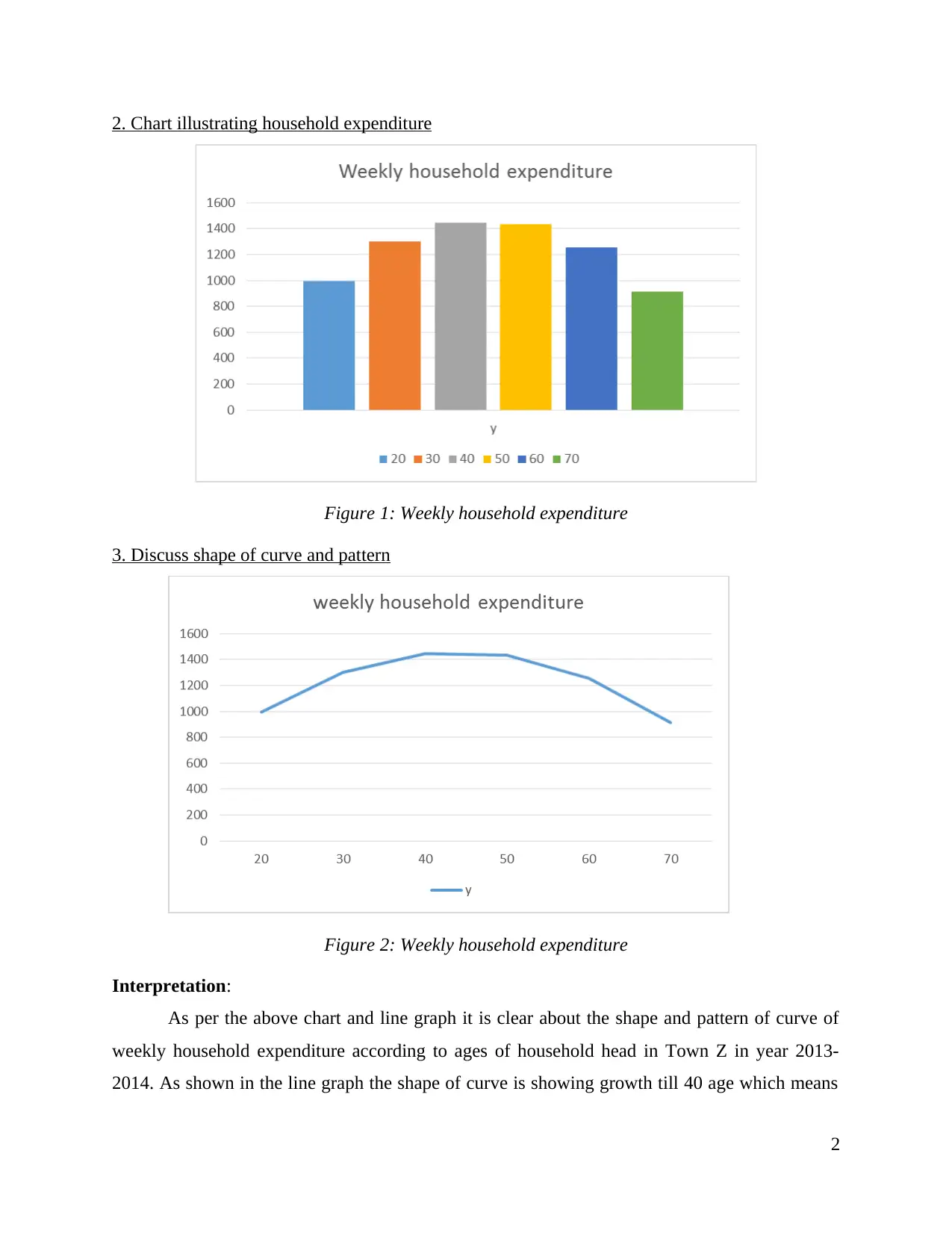
2. Chart illustrating household expenditure
Figure 1: Weekly household expenditure
3. Discuss shape of curve and pattern
Figure 2: Weekly household expenditure
Interpretation:
As per the above chart and line graph it is clear about the shape and pattern of curve of
weekly household expenditure according to ages of household head in Town Z in year 2013-
2014. As shown in the line graph the shape of curve is showing growth till 40 age which means
2
Figure 1: Weekly household expenditure
3. Discuss shape of curve and pattern
Figure 2: Weekly household expenditure
Interpretation:
As per the above chart and line graph it is clear about the shape and pattern of curve of
weekly household expenditure according to ages of household head in Town Z in year 2013-
2014. As shown in the line graph the shape of curve is showing growth till 40 age which means
2
Paraphrase This Document
Need a fresh take? Get an instant paraphrase of this document with our AI Paraphraser
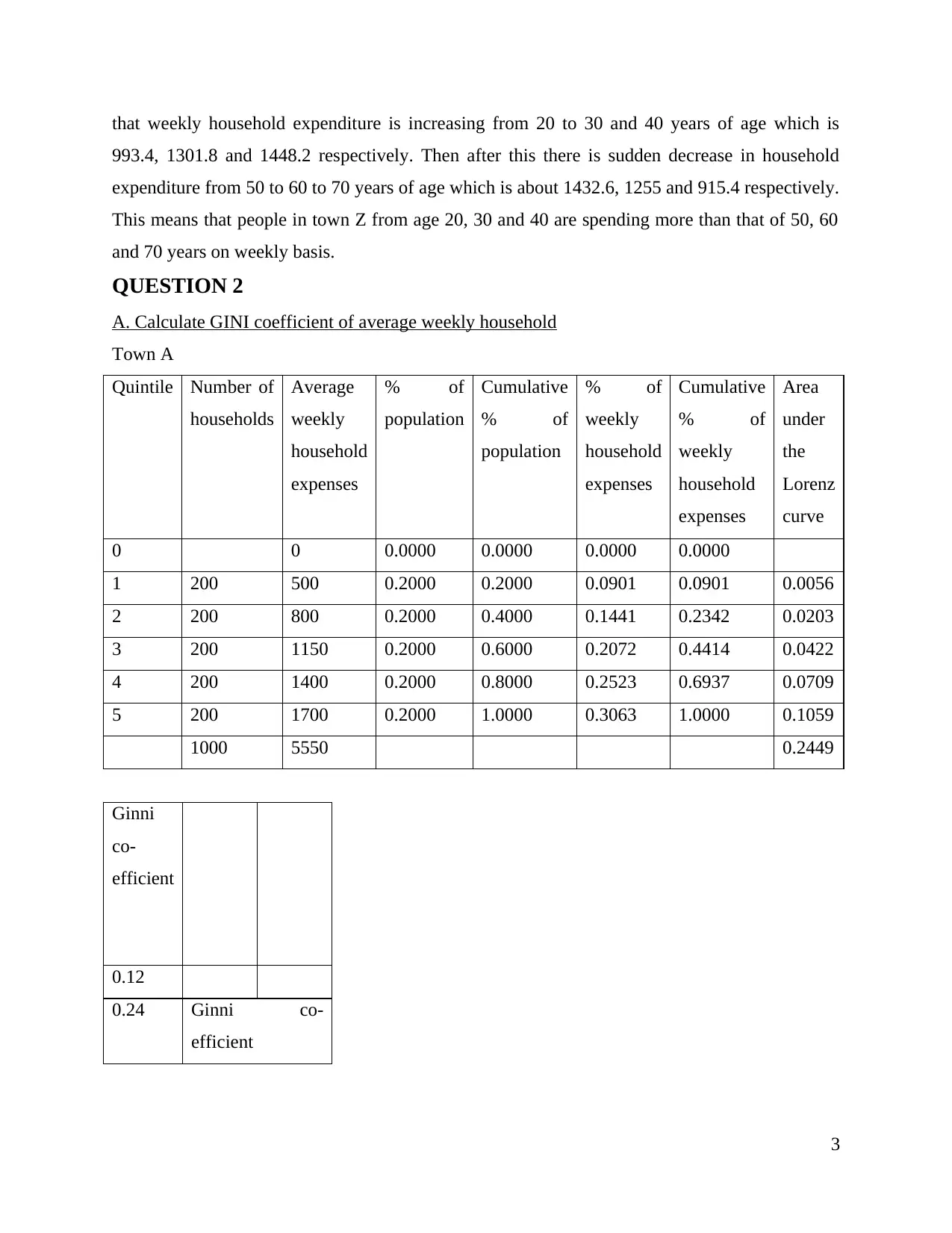
that weekly household expenditure is increasing from 20 to 30 and 40 years of age which is
993.4, 1301.8 and 1448.2 respectively. Then after this there is sudden decrease in household
expenditure from 50 to 60 to 70 years of age which is about 1432.6, 1255 and 915.4 respectively.
This means that people in town Z from age 20, 30 and 40 are spending more than that of 50, 60
and 70 years on weekly basis.
QUESTION 2
A. Calculate GINI coefficient of average weekly household
Town A
Quintile Number of
households
Average
weekly
household
expenses
% of
population
Cumulative
% of
population
% of
weekly
household
expenses
Cumulative
% of
weekly
household
expenses
Area
under
the
Lorenz
curve
0 0 0.0000 0.0000 0.0000 0.0000
1 200 500 0.2000 0.2000 0.0901 0.0901 0.0056
2 200 800 0.2000 0.4000 0.1441 0.2342 0.0203
3 200 1150 0.2000 0.6000 0.2072 0.4414 0.0422
4 200 1400 0.2000 0.8000 0.2523 0.6937 0.0709
5 200 1700 0.2000 1.0000 0.3063 1.0000 0.1059
1000 5550 0.2449
Ginni
co-
efficient
0.12
0.24 Ginni co-
efficient
3
993.4, 1301.8 and 1448.2 respectively. Then after this there is sudden decrease in household
expenditure from 50 to 60 to 70 years of age which is about 1432.6, 1255 and 915.4 respectively.
This means that people in town Z from age 20, 30 and 40 are spending more than that of 50, 60
and 70 years on weekly basis.
QUESTION 2
A. Calculate GINI coefficient of average weekly household
Town A
Quintile Number of
households
Average
weekly
household
expenses
% of
population
Cumulative
% of
population
% of
weekly
household
expenses
Cumulative
% of
weekly
household
expenses
Area
under
the
Lorenz
curve
0 0 0.0000 0.0000 0.0000 0.0000
1 200 500 0.2000 0.2000 0.0901 0.0901 0.0056
2 200 800 0.2000 0.4000 0.1441 0.2342 0.0203
3 200 1150 0.2000 0.6000 0.2072 0.4414 0.0422
4 200 1400 0.2000 0.8000 0.2523 0.6937 0.0709
5 200 1700 0.2000 1.0000 0.3063 1.0000 0.1059
1000 5550 0.2449
Ginni
co-
efficient
0.12
0.24 Ginni co-
efficient
3

Town B
Quintile Number of
households
Average
weekly
household
expenses
% of
population
Cumulative
% of
population
% of
weekly
household
expenses
Cumulative
% of
weekly
household
expenses
Area
under
the
Lorenz
curve
0 0 0.0000 0.0000 0.0000 0.0000
1 200 900 0.2000 0.2000 0.1525 0.1525 0.0095
2 200 1000 0.2000 0.4000 0.1695 0.3220 0.0297
3 200 1200 0.2000 0.6000 0.2034 0.5254 0.0530
4 200 1300 0.2000 0.8000 0.2203 0.7458 0.0794
5 200 1500 0.2000 1.0000 0.2542 1.0000 0.1091
1000 5900 0.2807
Ginni
co-
efficient
0.14
0.28 Ginni co-
efficient
B. Comment on difference in GINI Coefficient
Gini index of coefficient is that statistical measure which will be considered for
distributing of income, wealth and expenses as well. This will often be used for gauge of
economic inequality and measuring of income distribution. So as per the above calculation both
town A and B are having almost same gini coefficient which means that both of them are having
good and equal distribution of average weekly expenditure
4
Quintile Number of
households
Average
weekly
household
expenses
% of
population
Cumulative
% of
population
% of
weekly
household
expenses
Cumulative
% of
weekly
household
expenses
Area
under
the
Lorenz
curve
0 0 0.0000 0.0000 0.0000 0.0000
1 200 900 0.2000 0.2000 0.1525 0.1525 0.0095
2 200 1000 0.2000 0.4000 0.1695 0.3220 0.0297
3 200 1200 0.2000 0.6000 0.2034 0.5254 0.0530
4 200 1300 0.2000 0.8000 0.2203 0.7458 0.0794
5 200 1500 0.2000 1.0000 0.2542 1.0000 0.1091
1000 5900 0.2807
Ginni
co-
efficient
0.14
0.28 Ginni co-
efficient
B. Comment on difference in GINI Coefficient
Gini index of coefficient is that statistical measure which will be considered for
distributing of income, wealth and expenses as well. This will often be used for gauge of
economic inequality and measuring of income distribution. So as per the above calculation both
town A and B are having almost same gini coefficient which means that both of them are having
good and equal distribution of average weekly expenditure
4
⊘ This is a preview!⊘
Do you want full access?
Subscribe today to unlock all pages.

Trusted by 1+ million students worldwide
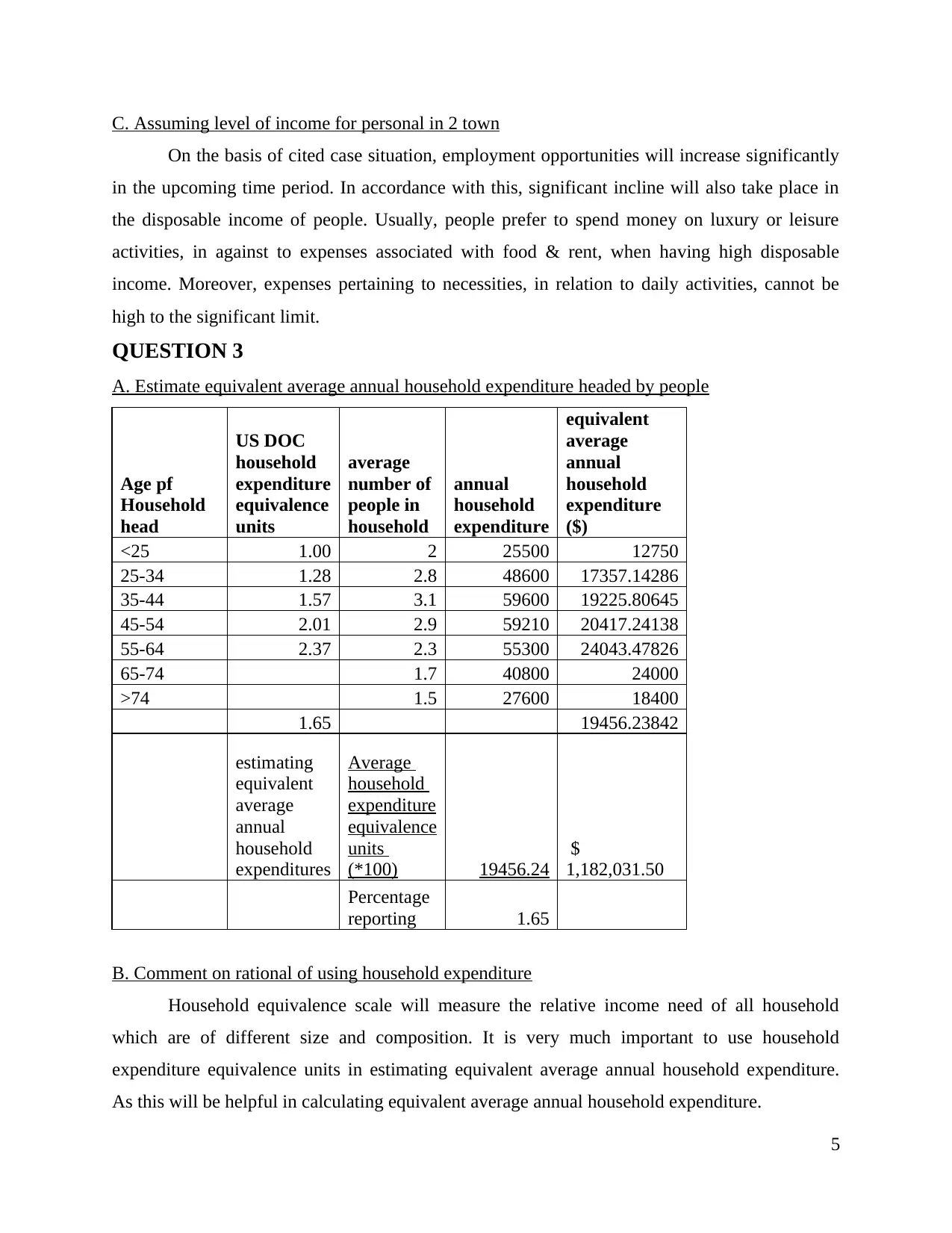
C. Assuming level of income for personal in 2 town
On the basis of cited case situation, employment opportunities will increase significantly
in the upcoming time period. In accordance with this, significant incline will also take place in
the disposable income of people. Usually, people prefer to spend money on luxury or leisure
activities, in against to expenses associated with food & rent, when having high disposable
income. Moreover, expenses pertaining to necessities, in relation to daily activities, cannot be
high to the significant limit.
QUESTION 3
A. Estimate equivalent average annual household expenditure headed by people
Age pf
Household
head
US DOC
household
expenditure
equivalence
units
average
number of
people in
household
annual
household
expenditure
equivalent
average
annual
household
expenditure
($)
<25 1.00 2 25500 12750
25-34 1.28 2.8 48600 17357.14286
35-44 1.57 3.1 59600 19225.80645
45-54 2.01 2.9 59210 20417.24138
55-64 2.37 2.3 55300 24043.47826
65-74 1.7 40800 24000
>74 1.5 27600 18400
1.65 19456.23842
estimating
equivalent
average
annual
household
expenditures
Average
household
expenditure
equivalence
units
(*100) 19456.24
$
1,182,031.50
Percentage
reporting 1.65
B. Comment on rational of using household expenditure
Household equivalence scale will measure the relative income need of all household
which are of different size and composition. It is very much important to use household
expenditure equivalence units in estimating equivalent average annual household expenditure.
As this will be helpful in calculating equivalent average annual household expenditure.
5
On the basis of cited case situation, employment opportunities will increase significantly
in the upcoming time period. In accordance with this, significant incline will also take place in
the disposable income of people. Usually, people prefer to spend money on luxury or leisure
activities, in against to expenses associated with food & rent, when having high disposable
income. Moreover, expenses pertaining to necessities, in relation to daily activities, cannot be
high to the significant limit.
QUESTION 3
A. Estimate equivalent average annual household expenditure headed by people
Age pf
Household
head
US DOC
household
expenditure
equivalence
units
average
number of
people in
household
annual
household
expenditure
equivalent
average
annual
household
expenditure
($)
<25 1.00 2 25500 12750
25-34 1.28 2.8 48600 17357.14286
35-44 1.57 3.1 59600 19225.80645
45-54 2.01 2.9 59210 20417.24138
55-64 2.37 2.3 55300 24043.47826
65-74 1.7 40800 24000
>74 1.5 27600 18400
1.65 19456.23842
estimating
equivalent
average
annual
household
expenditures
Average
household
expenditure
equivalence
units
(*100) 19456.24
$
1,182,031.50
Percentage
reporting 1.65
B. Comment on rational of using household expenditure
Household equivalence scale will measure the relative income need of all household
which are of different size and composition. It is very much important to use household
expenditure equivalence units in estimating equivalent average annual household expenditure.
As this will be helpful in calculating equivalent average annual household expenditure.
5
Paraphrase This Document
Need a fresh take? Get an instant paraphrase of this document with our AI Paraphraser
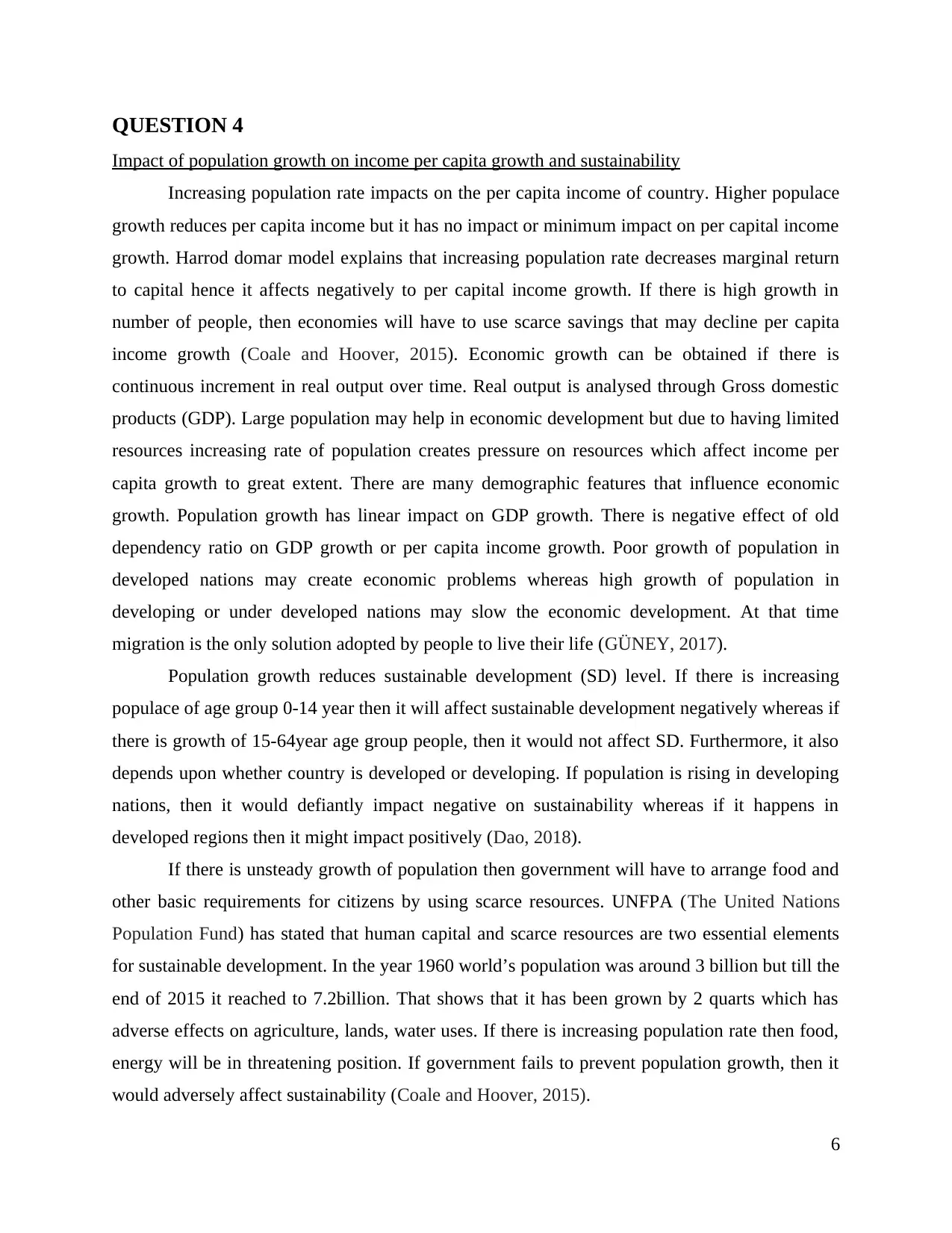
QUESTION 4
Impact of population growth on income per capita growth and sustainability
Increasing population rate impacts on the per capita income of country. Higher populace
growth reduces per capita income but it has no impact or minimum impact on per capital income
growth. Harrod domar model explains that increasing population rate decreases marginal return
to capital hence it affects negatively to per capital income growth. If there is high growth in
number of people, then economies will have to use scarce savings that may decline per capita
income growth (Coale and Hoover, 2015). Economic growth can be obtained if there is
continuous increment in real output over time. Real output is analysed through Gross domestic
products (GDP). Large population may help in economic development but due to having limited
resources increasing rate of population creates pressure on resources which affect income per
capita growth to great extent. There are many demographic features that influence economic
growth. Population growth has linear impact on GDP growth. There is negative effect of old
dependency ratio on GDP growth or per capita income growth. Poor growth of population in
developed nations may create economic problems whereas high growth of population in
developing or under developed nations may slow the economic development. At that time
migration is the only solution adopted by people to live their life (GÜNEY, 2017).
Population growth reduces sustainable development (SD) level. If there is increasing
populace of age group 0-14 year then it will affect sustainable development negatively whereas if
there is growth of 15-64year age group people, then it would not affect SD. Furthermore, it also
depends upon whether country is developed or developing. If population is rising in developing
nations, then it would defiantly impact negative on sustainability whereas if it happens in
developed regions then it might impact positively (Dao, 2018).
If there is unsteady growth of population then government will have to arrange food and
other basic requirements for citizens by using scarce resources. UNFPA (The United Nations
Population Fund) has stated that human capital and scarce resources are two essential elements
for sustainable development. In the year 1960 world’s population was around 3 billion but till the
end of 2015 it reached to 7.2billion. That shows that it has been grown by 2 quarts which has
adverse effects on agriculture, lands, water uses. If there is increasing population rate then food,
energy will be in threatening position. If government fails to prevent population growth, then it
would adversely affect sustainability (Coale and Hoover, 2015).
6
Impact of population growth on income per capita growth and sustainability
Increasing population rate impacts on the per capita income of country. Higher populace
growth reduces per capita income but it has no impact or minimum impact on per capital income
growth. Harrod domar model explains that increasing population rate decreases marginal return
to capital hence it affects negatively to per capital income growth. If there is high growth in
number of people, then economies will have to use scarce savings that may decline per capita
income growth (Coale and Hoover, 2015). Economic growth can be obtained if there is
continuous increment in real output over time. Real output is analysed through Gross domestic
products (GDP). Large population may help in economic development but due to having limited
resources increasing rate of population creates pressure on resources which affect income per
capita growth to great extent. There are many demographic features that influence economic
growth. Population growth has linear impact on GDP growth. There is negative effect of old
dependency ratio on GDP growth or per capita income growth. Poor growth of population in
developed nations may create economic problems whereas high growth of population in
developing or under developed nations may slow the economic development. At that time
migration is the only solution adopted by people to live their life (GÜNEY, 2017).
Population growth reduces sustainable development (SD) level. If there is increasing
populace of age group 0-14 year then it will affect sustainable development negatively whereas if
there is growth of 15-64year age group people, then it would not affect SD. Furthermore, it also
depends upon whether country is developed or developing. If population is rising in developing
nations, then it would defiantly impact negative on sustainability whereas if it happens in
developed regions then it might impact positively (Dao, 2018).
If there is unsteady growth of population then government will have to arrange food and
other basic requirements for citizens by using scarce resources. UNFPA (The United Nations
Population Fund) has stated that human capital and scarce resources are two essential elements
for sustainable development. In the year 1960 world’s population was around 3 billion but till the
end of 2015 it reached to 7.2billion. That shows that it has been grown by 2 quarts which has
adverse effects on agriculture, lands, water uses. If there is increasing population rate then food,
energy will be in threatening position. If government fails to prevent population growth, then it
would adversely affect sustainability (Coale and Hoover, 2015).
6
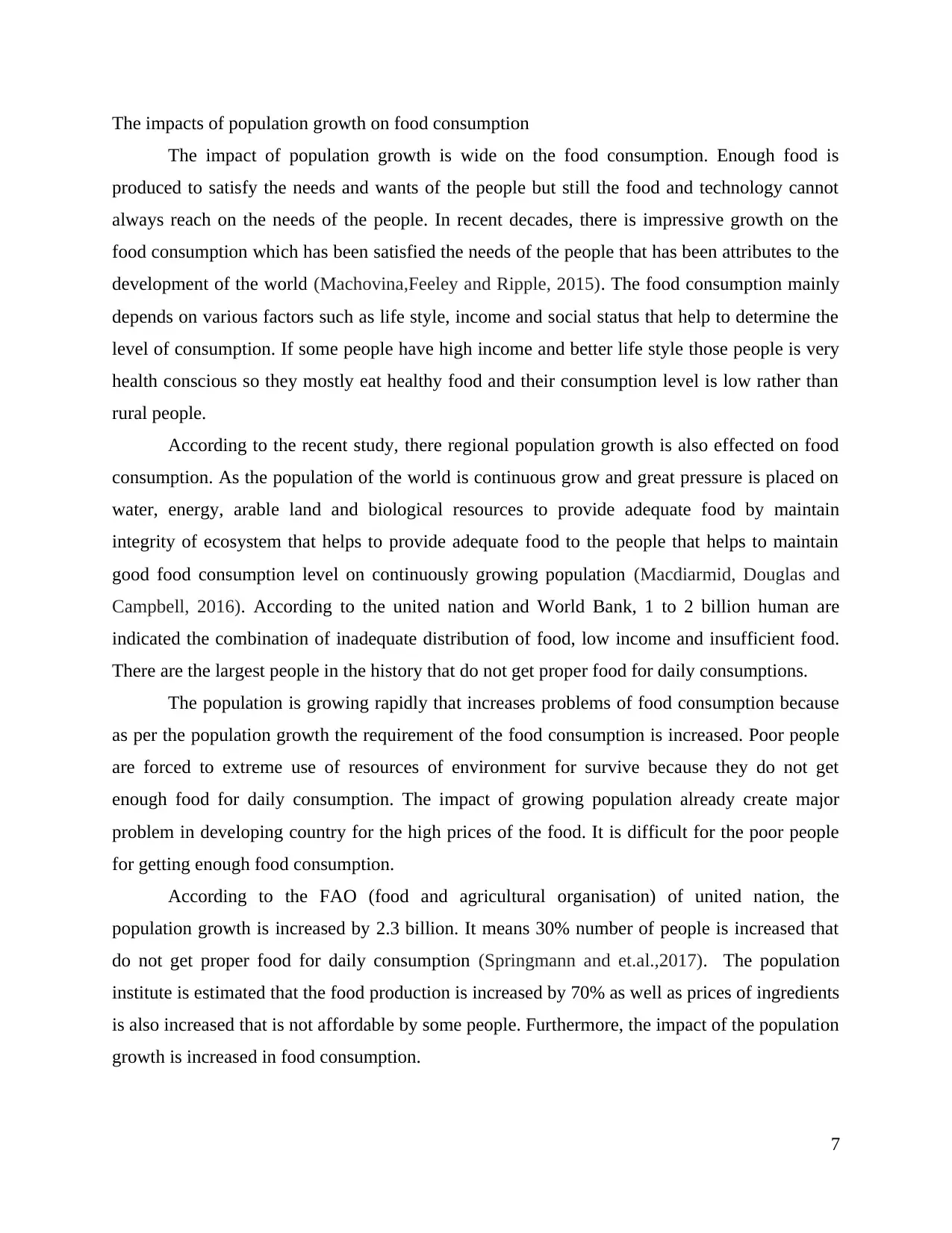
The impacts of population growth on food consumption
The impact of population growth is wide on the food consumption. Enough food is
produced to satisfy the needs and wants of the people but still the food and technology cannot
always reach on the needs of the people. In recent decades, there is impressive growth on the
food consumption which has been satisfied the needs of the people that has been attributes to the
development of the world (Machovina,Feeley and Ripple, 2015). The food consumption mainly
depends on various factors such as life style, income and social status that help to determine the
level of consumption. If some people have high income and better life style those people is very
health conscious so they mostly eat healthy food and their consumption level is low rather than
rural people.
According to the recent study, there regional population growth is also effected on food
consumption. As the population of the world is continuous grow and great pressure is placed on
water, energy, arable land and biological resources to provide adequate food by maintain
integrity of ecosystem that helps to provide adequate food to the people that helps to maintain
good food consumption level on continuously growing population (Macdiarmid, Douglas and
Campbell, 2016). According to the united nation and World Bank, 1 to 2 billion human are
indicated the combination of inadequate distribution of food, low income and insufficient food.
There are the largest people in the history that do not get proper food for daily consumptions.
The population is growing rapidly that increases problems of food consumption because
as per the population growth the requirement of the food consumption is increased. Poor people
are forced to extreme use of resources of environment for survive because they do not get
enough food for daily consumption. The impact of growing population already create major
problem in developing country for the high prices of the food. It is difficult for the poor people
for getting enough food consumption.
According to the FAO (food and agricultural organisation) of united nation, the
population growth is increased by 2.3 billion. It means 30% number of people is increased that
do not get proper food for daily consumption (Springmann and et.al.,2017). The population
institute is estimated that the food production is increased by 70% as well as prices of ingredients
is also increased that is not affordable by some people. Furthermore, the impact of the population
growth is increased in food consumption.
7
The impact of population growth is wide on the food consumption. Enough food is
produced to satisfy the needs and wants of the people but still the food and technology cannot
always reach on the needs of the people. In recent decades, there is impressive growth on the
food consumption which has been satisfied the needs of the people that has been attributes to the
development of the world (Machovina,Feeley and Ripple, 2015). The food consumption mainly
depends on various factors such as life style, income and social status that help to determine the
level of consumption. If some people have high income and better life style those people is very
health conscious so they mostly eat healthy food and their consumption level is low rather than
rural people.
According to the recent study, there regional population growth is also effected on food
consumption. As the population of the world is continuous grow and great pressure is placed on
water, energy, arable land and biological resources to provide adequate food by maintain
integrity of ecosystem that helps to provide adequate food to the people that helps to maintain
good food consumption level on continuously growing population (Macdiarmid, Douglas and
Campbell, 2016). According to the united nation and World Bank, 1 to 2 billion human are
indicated the combination of inadequate distribution of food, low income and insufficient food.
There are the largest people in the history that do not get proper food for daily consumptions.
The population is growing rapidly that increases problems of food consumption because
as per the population growth the requirement of the food consumption is increased. Poor people
are forced to extreme use of resources of environment for survive because they do not get
enough food for daily consumption. The impact of growing population already create major
problem in developing country for the high prices of the food. It is difficult for the poor people
for getting enough food consumption.
According to the FAO (food and agricultural organisation) of united nation, the
population growth is increased by 2.3 billion. It means 30% number of people is increased that
do not get proper food for daily consumption (Springmann and et.al.,2017). The population
institute is estimated that the food production is increased by 70% as well as prices of ingredients
is also increased that is not affordable by some people. Furthermore, the impact of the population
growth is increased in food consumption.
7
⊘ This is a preview!⊘
Do you want full access?
Subscribe today to unlock all pages.

Trusted by 1+ million students worldwide
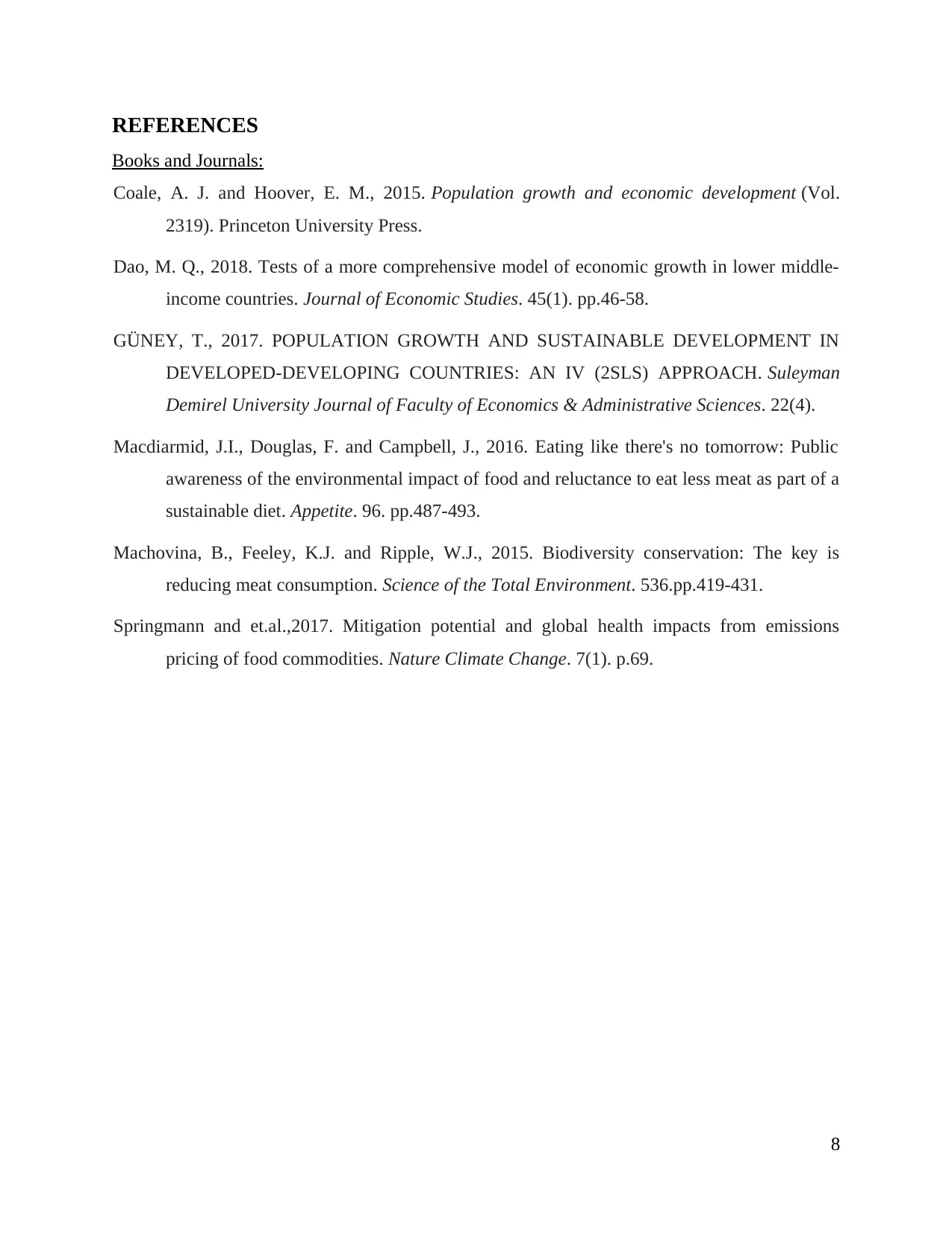
REFERENCES
Books and Journals:
Coale, A. J. and Hoover, E. M., 2015. Population growth and economic development (Vol.
2319). Princeton University Press.
Dao, M. Q., 2018. Tests of a more comprehensive model of economic growth in lower middle-
income countries. Journal of Economic Studies. 45(1). pp.46-58.
GÜNEY, T., 2017. POPULATION GROWTH AND SUSTAINABLE DEVELOPMENT IN
DEVELOPED-DEVELOPING COUNTRIES: AN IV (2SLS) APPROACH. Suleyman
Demirel University Journal of Faculty of Economics & Administrative Sciences. 22(4).
Macdiarmid, J.I., Douglas, F. and Campbell, J., 2016. Eating like there's no tomorrow: Public
awareness of the environmental impact of food and reluctance to eat less meat as part of a
sustainable diet. Appetite. 96. pp.487-493.
Machovina, B., Feeley, K.J. and Ripple, W.J., 2015. Biodiversity conservation: The key is
reducing meat consumption. Science of the Total Environment. 536.pp.419-431.
Springmann and et.al.,2017. Mitigation potential and global health impacts from emissions
pricing of food commodities. Nature Climate Change. 7(1). p.69.
8
Books and Journals:
Coale, A. J. and Hoover, E. M., 2015. Population growth and economic development (Vol.
2319). Princeton University Press.
Dao, M. Q., 2018. Tests of a more comprehensive model of economic growth in lower middle-
income countries. Journal of Economic Studies. 45(1). pp.46-58.
GÜNEY, T., 2017. POPULATION GROWTH AND SUSTAINABLE DEVELOPMENT IN
DEVELOPED-DEVELOPING COUNTRIES: AN IV (2SLS) APPROACH. Suleyman
Demirel University Journal of Faculty of Economics & Administrative Sciences. 22(4).
Macdiarmid, J.I., Douglas, F. and Campbell, J., 2016. Eating like there's no tomorrow: Public
awareness of the environmental impact of food and reluctance to eat less meat as part of a
sustainable diet. Appetite. 96. pp.487-493.
Machovina, B., Feeley, K.J. and Ripple, W.J., 2015. Biodiversity conservation: The key is
reducing meat consumption. Science of the Total Environment. 536.pp.419-431.
Springmann and et.al.,2017. Mitigation potential and global health impacts from emissions
pricing of food commodities. Nature Climate Change. 7(1). p.69.
8
1 out of 10
Related Documents
Your All-in-One AI-Powered Toolkit for Academic Success.
+13062052269
info@desklib.com
Available 24*7 on WhatsApp / Email
![[object Object]](/_next/static/media/star-bottom.7253800d.svg)
Unlock your academic potential
Copyright © 2020–2025 A2Z Services. All Rights Reserved. Developed and managed by ZUCOL.




